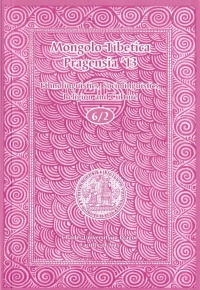Mongolo-Tibetica Pragensia ’13 Linguistics, Ethnolinguistics, Religion and Culture Volume 6, No. 2 (2013)

For acquisition please contact
This issue was prepared by Alena Oberfalzerová and Daniel Berounský
Editors-in-chief: Jaroslav Vacek and Alena Oberfalzerová
Editorial Board:
Daniel Berounský (Charles University in Prague, Czech Republic)
Agata Bareja-Starzyńska (University of Warsaw, Poland)
Katia Buffetrille (École pratique des Hautes-Études, Paris, France)
J. Lubsangdorji (Charles University Prague, Czech Republic)
Marie-Dominique Even (Centre National des Recherches Scientifiques, Paris, France)
Marek Mejor (University of Warsaw, Poland)
Tsevel Shagdarsurung (National University of Mongolia, Ulaanbaatar, Mongolia)
Domiin Tömörtogoo (National University of Mongolia, Ulaanbaatar, Mongolia)
Institute of South and Central Asia, Seminar of Mongolian Studies
Faculty of Philosophy, Charles University in Prague
Celetná 20, 116 42 Praha 1, Czech Republic
Publisher: Stanislav Juhaňák – TRITON
Praha (Prague) 2013
Registration number of MK ČR E 18436
ISSN 1803-5647
Contents
Daniel Berounský (Charles University in Prague)
Demonic tobacco in Tibet
In this paper, the subject of tobacco in Tibet is seen primarily through the genre of didactic literature discussing the evil of tobacco (tha ma kha’i nyes dmigs). The introductory parts attempt to summarise the bits and pieces left in the literature on attitudes towards tobacco in Tibet from an historical perspective. The myth of the origin of tobacco and the alleged ancient prophecies about tobacco are then discussed. They lead to the conclusion that a number of these texts probably originally concerned opium and that the phonetic similarity of the expressions for “final” (tha ma) and “tobacco” (tha ma kha) etc. played a role in later interpretations of the prophecies as speaking about tobacco. The paper concludes with a translation of the ban on cigarettes issued by the 13th Dalai Lama in 1918.
Nyima Woser Choekhortshang (Charles University, Prague)
The Ya-ngal family of Tibetan Royal priests in Dolpo, Part III
The present paper represents the third part of a work dealing with the Ya-ngal family from Dolpo in Nepal. It presents a translation of the larger part of genealogy of its family lineages of Dolpo and Mustang.The translation published here gives different readings of the various manuscripts in the footnotes and the original Tibetan text is appended to the paper.
Veronika Kapišovská (Charles University in Prague)
Oral Narratives of the Encounter between Agvaandandar lkharamba of Alashaa and Danzanravjaa, the Fifth Noyon Khutagt of Gobi
This paper focuses on the orally transmitted stories of the relationship between the two famous Mongolian literates – Danzanravjaa, the Fifth Noyon Khutagt of the Gobi (1803–1856), and Agvaandandar lkharamba of Alashaa (1759–1840). It provides original texts, translations and comparative notes of several stories collected from local sources in both (Khalkha) Mongolia and Alashaa, and gives available historical and biographical background of both literates, and a few other stories related to some significant moments in their lives.
Rachel Mikos (Charles University in Prague)
Hidden in plain sight: The story of “Mother Mongolia”
This article describes and analyzes a devotional image currently kept in the library of Gandantegc’inlen Monastery in Ulaanbaatar, Mongolia. Created during the late Communist period, the image, entitled “Mother Mongolia” (Mongol eez’), is actually an image of Green Tārā in disguise. The image of Mother Mongolia should be located within the paradigms of both traditional Mongolian visual culture as well as the visual culture of the USSR (of which Mongolia was a satellite state). In this article, I examine the visual strategies of subterfuge employed by the unknown creator of the image of Mother Mongolia in order to be able to display an image of Green Tārā openly, during an era when the display of such images would normally have been forbidden. At the same time, an analysis of the discourse that formed around this image as part of the interview with the Buddhist monk B. Mo’nhbaatar reveals the cognitive and religious-philosophical strategies that formed an integral part of the reception or “correct viewing” of this image. This article is part of a larger planned study entitled “The Visual Culture of Mongolian Buddhism.”
Miriam Löwensteinová (Charles University in Prague)
Yu Sunbee (Hankuk University of Foreign Studies)
Scenic Impromptu of Kim Sakkat
This article deals with a relatively well-known theme, i.e. scenic images in classical Korean poetry. The first part briefly examines the formal structure and requirements of Korean pre-modern poetry; it stresses the role of traditional technique in composing poems, the schemes of the plot and the most frequent motifs. The key part concentrates on the poetry of the vagabond poet Kim Sakkat (김삿갓, 金笠), the most controversial personality in the classical Korean hansi (漢詩) poetry written in classical Chinese, hanmun (漢文). It classifies motifs, invariants and deviations from the prescribed canonical scenes, also mentions themes and technique of no precedent, especially his language experiments.
Review section
Nicola Schneider, Le renouncement au féminin: Couvents et nonnes dans le bouddhisme tibétain [Renouncement of the Feminine: Convents and Nuns in Tibetan Buddhism]. Presses Universitaires de Paris Ouest, Nanterre 2013, 436 pp.; Paperback: 25 €; ISBN 978‑2‑84016‑133‑2 – Reviewed by Rachel Mikos
Delaplace, Grégory, L’invention des morts. Sépultures, fantômes et photographie en Mongolie contemporaine, Centre d'Études Mongoles et Sibériennes- École Pratique des Hautes Études, Paris 2008, 374 pp.; 29€; ISBN 978‑2‑9518888‑4‑6, ISSN 0766–5075 – Reviewed by Jonáš Vlasák
Scherrer-Schaub, Cristina, ed., 2012, Old Tibetan Studies: Dedicated to the Memory of R.E. Emmerick. Brill, Leiden-Boston, 254 pp.; ISBN 978‑90‑04‑15517‑6, price 101€ – reviewed by Daniel Berounský

